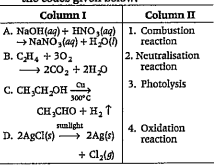Match different organisms in column I with their related characteristics in column Il and select the correct option from the codes given below.
Column IColumn II(a) Entamoeba histolytica(i) Abrown alga which is a rich source of iodine(b) Bacteriophage(ii) A protozoan that in humanbeings by living in the large intestine of humans(c )Penicillium(iii)A virus which infects a bacterial cell(d) Fucus(iv) A fungus used to obtain antibiotic
(a) - (ii), (b) - (iii), (c) - (iv), (d) - (i)
(a) - (iii), (b) - (ii), (c) - (iv), (d) - (i)
(a) - (ii), (b) - (i), (c) - (iii), (d) - (iv)
(a) - (iv), (b) - (ii), (c) - (i), (d) - (iii)
The correct Answer is:A
To solve the matching question, we need to pair the organisms listed in Column I with their corresponding characteristics in Column II. Let's go through each organism one by one:
1. Entamoeba histolytica:
- This is a protozoan that acts as a parasite in humans, specifically living in the large intestine.
- Therefore, it matches with (ii) "A protozoan that lives in the large intestine of humans."
2. Bacteriophage:
- A bacteriophage is a type of virus that specifically infects and kills bacteria.
- Thus, it corresponds to (iii) "A virus which infects a bacterial cell."
3. Penicillium:
- Penicillium is a fungus that is well-known for producing the antibiotic penicillin.
- Hence, it matches with (iv) "A fungus used to obtain antibiotic."
4. Fucus:
- Fucus is a type of brown algae that is recognized for being a rich source of iodine.
- Therefore, it corresponds to (i) "A brown alga which is a rich source of iodine."
Now, let's summarize the matches:
- (a) Entamoeba histolytica → (ii)
- (b) Bacteriophage → (iii)
- (c) Penicillium → (iv)
- (d) Fucus → (i)
So the correct option from the codes given would be A.
- This is a protozoan that acts as a parasite in humans, specifically living in the large intestine.
- Therefore, it matches with (ii) "A protozoan that lives in the large intestine of humans."
- A bacteriophage is a type of virus that specifically infects and kills bacteria.
- Thus, it corresponds to (iii) "A virus which infects a bacterial cell."
- Penicillium is a fungus that is well-known for producing the antibiotic penicillin.
- Hence, it matches with (iv) "A fungus used to obtain antibiotic."
- Fucus is a type of brown algae that is recognized for being a rich source of iodine.
- Therefore, it corresponds to (i) "A brown alga which is a rich source of iodine."
- (a) Entamoeba histolytica → (ii)
- (b) Bacteriophage → (iii)
- (c) Penicillium → (iv)
- (d) Fucus → (i)
Topper's Solved these Questions
- MICROORGANISMSBOOK - SCIENCE OLYMPIAD FOUNDATION CHAPTER - MICROORGANISMSEXERCISE - ACHIEVERS SECTION (HOTS)
5 Videos
- CROP PRODUCTION AND MANAGEMENTBOOK - SCIENCE OLYMPIAD FOUNDATION CHAPTER - CROP PRODUCTION AND MANAGEMENTEXERCISE - ACHIEVERS SECTION (HOTS)
5 Videos
- NSO MODEL TEST PAPER -1BOOK - SCIENCE OLYMPIAD FOUNDATION CHAPTER - NSO MODEL TEST PAPER -1EXERCISE - ACHIEVERS SECTION
2 Videos
Similar Questions
Knowledge Check
Match the columns-I with column II and select the correct option from the codes given below.
 A(A)-(i), (B)-(iv), (C)-(iii), (D)-(ii), (E)-(v)B(A)-(iii), (B)-(v), (C)-(ii), (D)-(i), (E)-(iv)C(A)-(ii), (B)-(iii), (C)-(v), (D)-(i), (E)-(iv)D(A)-(v), (B)-(iv), (C)-(i), (D)-(ii), (E)-(iii)
A(A)-(i), (B)-(iv), (C)-(iii), (D)-(ii), (E)-(v)B(A)-(iii), (B)-(v), (C)-(ii), (D)-(i), (E)-(iv)C(A)-(ii), (B)-(iii), (C)-(v), (D)-(i), (E)-(iv)D(A)-(v), (B)-(iv), (C)-(i), (D)-(ii), (E)-(iii)Match the column I with column II and select the correct option from the codes given below.
 AA - (i), B - (ii), C-(iii), D - (iv)BA - (iv), B - (i), C-(ii), D- (iii)CA - (iv), B - (iii), C-(ii), D- (i)DA - (iii), B - (iv), C-(i), D - (ii)
AA - (i), B - (ii), C-(iii), D - (iv)BA - (iv), B - (i), C-(ii), D- (iii)CA - (iv), B - (iii), C-(ii), D- (i)DA - (iii), B - (iv), C-(i), D - (ii)Match the column I with column II and select the correct option from the codes given below.
 AA - (i), B - (ii), C-(iii), D - (iv)BA - (iv), B - (i), C-(ii), D- (iii)CA - (iv), B - (iii), C-(ii), D- (i)DA - (iii), B - (iv), C-(i), D - (ii)
AA - (i), B - (ii), C-(iii), D - (iv)BA - (iv), B - (i), C-(ii), D- (iii)CA - (iv), B - (iii), C-(ii), D- (i)DA - (iii), B - (iv), C-(i), D - (ii)
Match the column I with column II and select the correct option from the codes given below

View SolutionMatch the column I with column II and select the correct option from the codes given below

View SolutionMatch the column I with column II and select the correct option from the codes given below

View SolutionMatch the column I with column II and select the correct option from the codes given below

View SolutionMatch column I with column II and select the correct option from the codes given below.

View Solution


